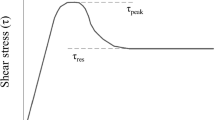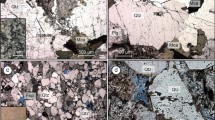Abstract
Field and monitoring evidences show that deformation in a rockslide is predominantly localized along a basal shear zone. Mineralogic, grain size, thickness, and fabric characteristics of the shear zone control its behavior and the possible evolution of the rockslide from a slow creeping to a fast moving one. Standard experimental tests can characterize the material from the strength and the deformability, but they are not able to reproduce the in-situ conditions. In this paper, we discuss the results from campaign of experimental tests to characterize the shear zone behavior sampled from a rock-slide. In particular, the shear zone behavior and its evolution are investigated via conventional (direct shear, standard triaxial) and unconventional laboratory testing (with a LHV low-to-high-velocity ring shear apparatus). By LHV tests, it is possible to impose and monitor shearing displacement and velocity and the pore water pressure, simulating in-situ conditions. The tests were carried out on samples collected from boreholes through cataclastic shear zones from the Mont de La Saxe rockslide (Western Italian Alps) containing both phyllosilicates (XRF quantify in about 20%) and graphite (about 10%). Investigations reveal a grain-size reduction in some tests (up to 1%) and a preferential particle alignment in the shear zone. Mechanical investigations evidence a marked creep behavior characterized by two stages after the application of the loading steps. Nevertheless, the stress increments are imposed with a prefixed value, and the viscous displacement rate increases due to the damaging process. Finally, the mean values of the viscous parameters are computed considering Newtonian viscosity law range from 6.40 × 106 to 6.39 × 107 kPa s for the transition phase and from 2.01 × 108 to 5.89 × 109 kPa s for the steady state and according to the tangential stress increment.












Similar content being viewed by others
References
Agung MW, Sassa K, Fukuoka H, Wang G (2004) Evolution of shear-zone structure in undrained ring-shear tests. Landslides 1(2):101–112
Aladekomo JB, Bragg RH (1990) Structural transformations induced in graphite by grinding: analysis of 002 X-ray diffraction line profiles. Carbon 28(6):897–906
Angeli M-G, Gasparetto P, Menotti RM, Pasuto A, Silvano S (1996) A visco-plastic model for slope analysis applied to a mudslide in Cortina d’Ampezzo, Italy. Q J Eng Geol Hydrogeol 29(3):233–240
Antoine P, Pairis J, Pairis B (1975) Quelques observations nouvelles sur la structure de la couverture sedimentaire interne du massif du mont-blanc, entre le Col du Ferret (frontiere Italo-Suisse) et la tete des fours (Savoie, France). Geol Alpine 51:5–23
ASTM D4318-17e1 (2017). Standard test methods for liquid limit, plastic limit, and plasticity index of soils, ASTM International, West Conshohocken, PA
ASTM D6913/D6913M-17 (2017). Standard test methods for particle-size distribution (gradation) of soils using sieve analysis, ASTM International, West Conshohocken, PA
Bishop AW, Green GE, Garga VK, Andresen A, Brown JD (1971) A new ring shear apparatus and its application to the measurement of residual strength. Geotechnique 21(4):273–328
Broccolato, M., Cancelli, P., Crosta, G. B., Tamburini, A., and Alberto, W. (2011). Tecniche di rilievo e monitoraggio della frana di mont de la saxe (Courmayeur). XXIV Convegno Nazionale di Geotecnica, Innovazione Tecnologica nell’ingegneria Geotecnica, Napoli
Bromhead, E. N., and Dixon, N. (1984). Porewater pressure observations in the coastal cliffs at the Isle of Sheppey, England. Proc., 4th Int. Symposium on Landslides, Toronto, 1, 385–390
Collettini C, Niemeijer A, Viti C, Marone C (2009) Fault zone fabric and fault weakness. Nature 462(7275):907–910
Corominas J, Moya J, Ledesma A, Lloret A, Gili JA (2005) Prediction of ground displacements and velocities from groundwater level changes at the Vallcebre landslide (Eastern Pyrenees, Spain). Landslides 2(2):83–96
Crosta GB, Di Prisco C, Frattini P, Frigerio G, Castellanza R, Agliardi F (2014) Chasing a complete understanding of the triggering mechanisms of a large rapidly evolving rockslide. Landslides 11(5):747–764
Di Maio C, Vassallo R, Vallario M (2013) Plastic and viscous shear displacements of a deep and very slow landslide in stiff clay formation. Eng Geol 162:53–66
Engl DA, Fellin W, Kieffer DS, Zangerl C (2010) A novel approach for assessing the deformation characteristics of a rockslide. In: Williams AL, Pinches GM, Chin CY, McMorran TJ, Massey CI (eds) Proceedings of the 11th IAEG congress. Taylor & Francis, Auckland, pp 1530–1545
Feda J (2002) Notes on the effect of grain crushing on the granular soil behaviour. Eng Geol 63(1–2):93–98
Fernández-Merodo JA, García-Davalillo JC, Herrera G, Mira P, Pastor M (2014) 2D viscoplastic finite element modelling of slow landslides: the Portalet case study (Spain). Landslides 11(1):29–42
Fossen H, Cavalcante GCG (2017) Shear zones–a review. Earth Sci Rev 171:434–455
Fukuoka H, Sassa K, Wang G, Sasaki R (2006) Observation of shear zone development in ring-shear apparatus with a transparent shear box. Landslides 3:239–251
Gasparetto P, Mosselman M, Van Asch TW (1996) The mobility of the Alvera landslide (Cortina d’Ampezzo, Italy). Geomorphology 15(3–4):327–335
Henderson IHC, Ganerød GV, Braathen A (2010) The relationship between particle characteristics and frictional strength in basal fault breccias: implications for fault-rock evolution and rockslide susceptibility. Tectonophysics 486:132–149
Hu W, Xu Q, Wang G, Scaringi G, Mcsaveney M, Hicher PY (2017) Shear resistance variations in experimentally sheared mudstone granules: a possible shear-thinning and thixotropic mechanism. Geophys Res Lett 44(21):11,040–11,050
Hutchinson JN (1969) A reconsideration of the coastal landslides at Folkestone Warren, Kent. Geotechnique 19(1):6–38
Kenney, T. C. (1967). The influence of mineral composition on the residual strength of natural soils
KristmannsdÓttir, H. (1979). Alteration of Basaltic Rocks by Hydrothermal-Activity at 100–300 C. In Developments in sedimentology (Vol. 27, pp. 359–367). Elsevier
Larson, A. C. and R. B. Von Dreele. 1994. General Structure Analysis System (GSAS) Manual. LANSCE, MS-H805, Los Alamos National Laboratory, Los Alamos, NM
Leloup P, Arnaud N, Sobel E, Lacassin R (2005) Alpine thermal and structural evolution of the highest external crystalline massif: the mont blanc. Tectonics 24(4)
Lupini JF, Skinner AE, Vaughan PR (1981) The drained residual strength of cohesive soils. Geotechnique 31(2):181–213
Luzzani L, Coop MR (2002) On the relationship between particle breakage and the critical state of sands. Soils Found 42(2):71–82
Moore DE, Lockner DA (2008) Talc friction in the temperature range 25–400 C: relevance for fault-zone weakening. Tectonophysics 449(1–4):120–132
Okada Y, Sassa K, Fukuoka H (2004) Excess pore pressure and grain crushing of sands by means of undrained and naturally drained ring-shear tests. Eng Geol 75(3–4):325–343
Oohashi K, Hirose T, Shimamoto T (2011) Shear-induced graphitization of carbonaceous materials during seismic fault motion: experiments and possible implications for fault mechanics. J Struct Geol 33(6):1122–1134
Oohashi K, Hirose T, Kobayashi K, Shimamoto T (2012) The occurrence of graphite-bearing fault rocks in the Atotsugawa fault system, Japan: origins and implications for fault creep. J Struct Geol 38:39–50
Perello P, Piana F, Martinotti G (1999) Neo-alpine structural features at the boundary between the penninic and helvetic domains (pr’e s. didier-entr’eves, aosta valley, Italy). Eclogae Geol Helv 92:347–359
Ranalli M, Gottardi G, Medina-Cetina Z, Nadim F (2009) Uncertainty quantification in the calibration of a dynamic viscoplastic model of slow slope movements. Landslides 7(1):31–41
Sassa K (1988) Special lecture: geotechnical model for the motion of landslides. In Landslides, Proceedings of the 5th International Symposium on Landslides, Lausanne, Switzerland. Edited by C. Bonnard. A.A. Balkema, Rotterdam, The Netherlands, Vol. 1, pp. 37–55
Sassa K (1997) A new intelligent-type dynamic loading ring shear apparatus. Landslide News 10:33
Sassa K, Wang G, Fukuoka H (2003) Performing undrained shear tests on saturated sands in a new intelligent type of ring shear apparatus. Geotech Test J 26(3):257–265
Sassa K, Fukuoka H, Wang G, Ishikawa N (2004) Undrained dynamic-loading ring-shear apparatus and its application to landslide dynamics. Landslides 1(1):7–19
Schäbitz M, Janssen C, Wenk HR, Wirth R, Schuck B, Wetzel HU, Dresen G (2018) Microstructures in landslides in northwest China–implications for creeping displacements? J Struct Geol 106:70–85
Schulze, D. G. (1994). Differential X-ray diffraction analysis of soil minerals. Quantitative methods in soil mineralogy, (quantitativemet), 412–429
Schulz WH, Smith JB, Wang G, Jiang Y, Roering JJ (2018) Clayey landslide initiation and acceleration strongly modulated by soil swelling. Geophys Res Lett 45(4):1888–1896
Skempton AW, Petley DJ (1967) The strength along structural discontinuities in stiff clays. Proc. Geotechnical Conf., Oslo 2:29–47
Skempton AW (1985) Residual strength of clays in landslides, folded strata and the laboratory. Geotechnique 35(1):3–18
Storti F, Billi A, Salvini F (2003) Particle size distributions in natural carbonate fault rocks: insights for non-self-similar cataclasis. Earth Planet Sci Lett 206(1–2):173–186
Strauhal T, Zangerl C, Fellin W, Holzmann M, Engl DA, Brandner R, Tropper P, Tessadri R (2017) Structure, mineralogy and geomechanical properties of shear zones of deep-seated rockslides in metamorphic rocks (Tyrol, Austria). Rock Mech Rock Eng 50(2):419–438
Tiwari B, Marui H (2005) A new method for the correlation of residual shear strength of the soil with mineralogical composition. J Geotech Geoenviron 131(9):1139–1150
Wang G, Sassa K (2003) Pore-pressure generation and movement of rainfall-induced landslides: effects of grain size and fine-particle content. Eng Geol 69(1–2):109–125
Wang G, Sassa K, Fukuoka H, Tada T (2007) Experimental study on the shearing behavior of saturated silty soils based on ring-shear tests. J Geotech Geoenviron 133(3):319–333
Wang G, Suemine A, Schulz WH (2010) Shear-rate-dependent strength control on the dynamics of rainfall-triggered landslides, Tokushima prefecture, Japan. Earth Surf Process Landf 35(4):407–416
Warr LN, Cox S (2001) Clay mineral transformations and weakening mechanisms along the alpine fault, New Zealand. Geol Soc Lond, Spec Publ 186(1):85–101
Wen BP, Aydin A, Duzgoren-Aydin NS, Li YR, Chen HY, Xiao SD (2007) Residual strength of slip zones of large landslides in the Three Gorges area, China. Eng Geol 93(3-4):82–98
Wenk H-R, Kanitpanyacharoen W, Voltolini M (2010) Preferred orientation of phyllosilicates: comparison of fault gouge, shale and schist. J Struct Geol 32(4):478–489
Yamasaki S, Chigira M (2011) Weathering mechanisms and their effects on landsliding in pelitic schist. Earth Surf Process Landf 36(4):481–494
Yamasaki S, Chigira M, Petley DN (2016) The role of graphite layers in gravitational deformation of pelitic schist. Eng Geol 208:29–38
Zangerl C, Eberhardt E, Perzlmaier S (2010) Kinematic behaviour and velocity characteristics of a complex deep-seated crystalline rockslide system in relation to its interaction with a dam reservoir. Eng Geol 112(1–4):53–67
Zulauf G, Kleinschmidt G, Oncken O (1990) Brittle deformation and graphitic cataclasites in the pilot research well KTB-VB (Oberpfalz, FRG). Geol Soc Lond, Spec Publ 54(1):97–103
Acknowledgments
S. Alberti was funded by a Regione Valle D’Aosta grant. We thank Davide Bertolo, Patrick Thuegaz and Mauro Ghilardini from the Regione Valle d’Aosta Geological Survey. We are grateful to Serena Rigamonti, Nicoletta Fusi, Paolo Gentile, Lucia Galimberti for support in the laboratory testing, and Toshitaka Kamai for hosting us at the DPRI Kyoto. We thank the editor and two anonymous reviewers for the comments which have ultimately contributed to the robustness of this paper. The data presented and discussed in this paper can be requested directly to the authors.
Author information
Authors and Affiliations
Corresponding author
Rights and permissions
About this article
Cite this article
Alberti, S., Wang, G., Dattola, G. et al. Physical mechanical characterization of a rockslide shear zone by standard and unconventional tests. Landslides 16, 739–750 (2019). https://doi.org/10.1007/s10346-018-01126-y
Received:
Accepted:
Published:
Issue Date:
DOI: https://doi.org/10.1007/s10346-018-01126-y




